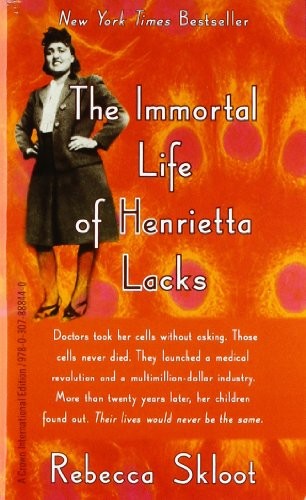Review of 'The Immortal life of Henrietta Lacks' on 'Goodreads'
1 star
this book is apparently inaccurate

Paperback, 480 pages
Published Feb. 25, 2011 by Crown Pub.
Her name was Henrietta Lacks, but scientists know her as HeLa. She was a poor black tobacco farmer whose cells—taken without her knowledge in 1951—became one of the most important tools in medicine, vital for developing the polio vaccine, cloning, gene mapping, in vitro fertilization, and more. Henrietta’s cells have been bought and sold by the billions, yet she remains virtually unknown, and her family can’t afford health insurance.
This New York Times bestseller takes readers on an extraordinary journey, from the “colored” ward of Johns Hopkins Hospital in the 1950s to stark white laboratories with freezers filled with HeLa cells, from Henrietta’s small, dying hometown of Clover, Virginia, to East Baltimore today, where her children and grandchildren live and struggle with the legacy of her cells. The Immortal Life of Henrietta Lacks tells a riveting story of the collision between ethics, race, and medicine; of scientific discovery and faith …
Her name was Henrietta Lacks, but scientists know her as HeLa. She was a poor black tobacco farmer whose cells—taken without her knowledge in 1951—became one of the most important tools in medicine, vital for developing the polio vaccine, cloning, gene mapping, in vitro fertilization, and more. Henrietta’s cells have been bought and sold by the billions, yet she remains virtually unknown, and her family can’t afford health insurance.
This New York Times bestseller takes readers on an extraordinary journey, from the “colored” ward of Johns Hopkins Hospital in the 1950s to stark white laboratories with freezers filled with HeLa cells, from Henrietta’s small, dying hometown of Clover, Virginia, to East Baltimore today, where her children and grandchildren live and struggle with the legacy of her cells. The Immortal Life of Henrietta Lacks tells a riveting story of the collision between ethics, race, and medicine; of scientific discovery and faith healing; and of a daughter consumed with questions about the mother she never knew. It’s a story inextricably connected to the dark history of experimentation on African Americans, the birth of bioethics, and the legal battles over whether we control the stuff we’re made of. ([source][1])
this book is apparently inaccurate
I picked up this book hoping it would tell me more about the HeLa cells and the background to them. It sort of does that, except it's really more a book about how the author gathered the information in the book - "I went here, met X, went somewhere else, met Y". As a result, it ends up feeling like the author has inserted herself into the story, and perhaps also got a bit too close to the participants.
For me, this is one of those books which isn't that fulfilling on its own, but a good jumping off point by following up the references etc.
very, very well written. the transition between science and personal life of not only henrietta but her family members as well was very smooth. the only thing was i kinda got whiplash from the afterword because it went straight into super technical stuff. i guess it is only an afterword though. very good book, and i recommend it to everybody, but especially people who are involved in molecular biology.
This is a really great book to listen to. It was narrated well.
The content was great - a very neat combination of personal stories and the very important history of medical science in the US and the racism of it. I highly recommend this book!
Will post my thoughts on Hive soon
this book was a great combination of story and science; i was one-third into it on the first day of reading and still didn't want to put it down.
the author heads each chapter with a timeline which makes the jumps between timeframes easy to follow and lets her see through one 'arm' of the story (of which there are many!). this must be one of the hardest things to balance: how to weave scientific discovery - which is incremental and is often attributed to many different scientists - into a story that encompasses not one, but 2 women's lives.
what results is a remarkable piece of non-fiction that couches the details of cancer research, gene mapping, the development of the polio vaccine, tissue culture and it's legal implications into a memoir.
Henrietta was a poor black woman living outside Baltimore at the time she discovered she had terminal cancer in 1951. When one of her doctors was able to keep her cancer cells (now known as HeLa cells) alive and growing indefinitely in the laboratory, it was one of the most important discoveries of modern oncology. But who was this woman who had unknowingly contributed so much to science at the moment of her death? Skloot expertly uncovers the mystery of the face behind the cells.
